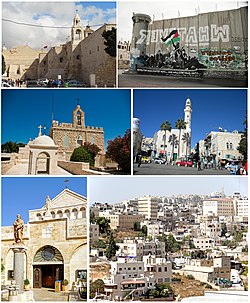
Back Betlehem Afrikaans Bethlehem ALS ቤተ ልሔም Amharic Betlem AN Beþþleæm ANG بيت لحم Arabic ܒܝܬ ܠܚܡ ARC بيت لحم ARZ Belén AST Beytləhm Azerbaijani
Bethlehem | |
|---|---|
| Arabic transcription(s) | |
| • Arabic | بيت لحم |
| • Latin | Beit Laḥm (official) Bayt Laḥm (unofficial) |
| Hebrew transcription(s) | |
| • Hebrew | בֵּית לֶחֶם |
 From top, left to right: Church of the Nativity, Graffiti on the Israeli West Bank barrier, Chapel of the Milk Grotto, Mosque of Omar in Manger Square, Church of St. Catherine and skyline of the city | |
 Municipal Seal (PNA) | |
Location of Bethlehem within the West Bank Location of Bethlehem within the State of Palestine | |
| Coordinates: 31°42′16″N 35°12′23″E / 31.70444°N 35.20639°E | |
| Country | |
| Governorate | Bethlehem |
| Founded | 1400 BCE (est.) |
| Government | |
| • Type | Area A City (from 1995) |
| • Head of Municipality | Anton Salman[1] |
| Area | |
| • Municipality type A | 10,611 dunams (10.611 km2 or 4.097 sq mi) |
| Population (2017)[2] | |
| • Municipality type A | 28,591 |
| • Density | 2,700/km2 (7,000/sq mi) |
| • Metro | 97,559 |
| Demonym | Bethlehemi |
| Etymology | House of Meat (Arabic); House of Bread (Hebrew, Aramaic) |
| Website | www.bethlehem-city.org |
Bethlehem (/ˈbɛθlɪhɛm/; Arabic: بيت لحم, Bayt Laḥm, ; Hebrew: בֵּית לֶחֶם Bēṯ Leḥem) is a city in the Israeli-occupied West Bank of the State of Palestine, located about ten kilometres (six miles) south of Jerusalem. It is the capital of the Bethlehem Governorate, and as of 2017 had a population of 28,591 people.[2] The city's economy is largely tourist-driven; international tourism peaks around and during Christmas, when Christians embark on a pilgrimage to the Church of the Nativity, revered as the location of the Nativity of Jesus.[3][4]
A possible first mention of Bethlehem is in the Amarna correspondence of ancient Egypt, dated to 1350–1330 BCE, although that reading is uncertain. In the Hebrew Bible, the period of the Israelites is described; it identifies Bethlehem as the birthplace of David.[5] In the New Testament, the city is identified as the birthplace of Jesus of Nazareth. Under the Roman Empire, the city of Bethlehem was destroyed by Hadrian, but later rebuilt by Constantine the Great, who commissioned the Church of the Nativity in 327 CE. In 529, the Church of the Nativity was heavily damaged by Samaritans involved in the Samaritan revolts; following the victory of the Byzantine Empire, it was rebuilt by Justinian I.
Amidst the Muslim conquest of the Levant, Bethlehem became part of Jund Filastin in 637. Muslims continued to rule the city until 1099, when it was conquered by the Crusaders, who replaced the local Christian Greek Orthodox clergy with Catholic ones. In the mid-13th century, Bethlehem's walls were demolished by the Mamluk Sultanate. However, they were rebuilt by the Ottoman Empire in the 16th century, following the Ottoman–Mamluk War.[6] After the dissolution of the Ottoman Empire at the end of World War I, it became part of Mandatory Palestine until 1948, when it was annexed by Jordan during the 1948 Arab–Israeli War. During the 1967 Six Day War, Bethlehem was occupied by Israel along with the rest of the West Bank. Since the Oslo Accords between Israel and the Palestinian National Authority, Bethlehem has been designated as part of Area A of the West Bank, nominally rendering it as being under Palestinian control.[6] Movement around the city is limited due to the Israeli West Bank barrier.
While it was historically a city of Arab Christians, Bethlehem now has a majority of Arab Muslims; while it is still home to a significant population of Palestinian Christians, this community has dwindled significantly, mostly due to difficulties resulting from living under the Israeli occupation.[7] Presently, Bethlehem has become encircled by dozens of Israeli settlements, which significantly hinder the ability of Palestinians in the city to openly access their land and livelihoods, which has contributed to the exodus of Palestinians.[8]
- ^ "Members of the Municipal Council". Bethlehem municipality. Archived from the original on October 20, 2018. Retrieved August 2, 2018.
- ^ a b "Preliminary Results of the Population, Housing and Establishments: Census 2017" (PDF). Palestinian Central Bureau of Statistics. Retrieved October 26, 2023.
- ^ Kaufman, David; Katz, Marisa S. (April 16, 2006). "In the West Bank, Politics and Tourism Remain Bound Together Inextricably – New York Times". The New York Times. Archived from the original on June 15, 2013. Retrieved January 22, 2008.
- ^ "Places to Visit In & Around Bethlehem". Bethlehem Hotel. Archived from the original on December 3, 2013. Retrieved November 29, 2013.
- ^ 2 Chronicles 11:5–6 (Note: Though v. 6 is frequently translated to say simply that Rehoboam built the city, the Hebrew phrase in v. 5, just prior, וַיִּ֧בֶן עָרִ֛ים לְמָצ֖וֹר wayyiḇen ‘ārîm lemāṣôr means "(and) he built cities into fortresses". Verse 5 is cited by at least one prominent Hebrew lexicon in illustration of this fact. See Koehler, L., Baumgartner, W., Richardson, M. E. J., & Stamm, J. J., The Hebrew and Aramaic Lexicon of the Old Testament (electronic edition; Leiden: E.J. Brill, 1994–2000), entry for the pertinent root בנה bnh, p. 139. Def. 3 reads as follows: "—3. with לְ to develop buildings: עָרִים לְמָצוֹר cities into fortresses 2C[hronicles] 11:5".)
- ^ a b "History and Mithology of Bethlehem". Bethlehem Municipality. Archived from the original on January 13, 2008. Retrieved January 22, 2008.
- ^ Cite error: The named reference
AJ1was invoked but never defined (see the help page). - ^ Philp, Catherine (December 24, 2013). "Settlements choke peace in the little town of Bethlehem". The Times. pp. 28–29.
© MMXXIII Rich X Search. We shall prevail. All rights reserved. Rich X Search

